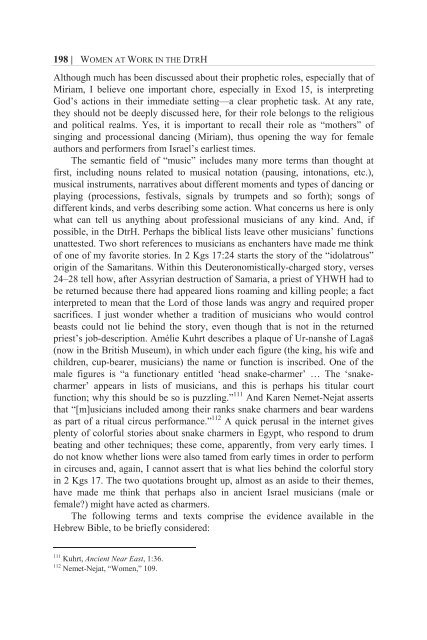Women at Work in the Deuteronomistic History - International Voices ...
Women at Work in the Deuteronomistic History - International Voices ...
Women at Work in the Deuteronomistic History - International Voices ...
You also want an ePaper? Increase the reach of your titles
YUMPU automatically turns print PDFs into web optimized ePapers that Google loves.
198 | WOMEN AT WORK IN THE DTRH<br />
Although much has been discussed about <strong>the</strong>ir prophetic roles, especially th<strong>at</strong> of<br />
Miriam, I believe one important chore, especially <strong>in</strong> Exod 15, is <strong>in</strong>terpret<strong>in</strong>g<br />
God’s actions <strong>in</strong> <strong>the</strong>ir immedi<strong>at</strong>e sett<strong>in</strong>g—a clear prophetic task. At any r<strong>at</strong>e,<br />
<strong>the</strong>y should not be deeply discussed here, for <strong>the</strong>ir role belongs to <strong>the</strong> religious<br />
and political realms. Yes, it is important to recall <strong>the</strong>ir role as “mo<strong>the</strong>rs” of<br />
s<strong>in</strong>g<strong>in</strong>g and processional danc<strong>in</strong>g (Miriam), thus open<strong>in</strong>g <strong>the</strong> way for female<br />
authors and performers from Israel’s earliest times.<br />
The semantic field of “music” <strong>in</strong>cludes many more terms than thought <strong>at</strong><br />
first, <strong>in</strong>clud<strong>in</strong>g nouns rel<strong>at</strong>ed to musical not<strong>at</strong>ion (paus<strong>in</strong>g, <strong>in</strong>ton<strong>at</strong>ions, etc.),<br />
musical <strong>in</strong>struments, narr<strong>at</strong>ives about different moments and types of danc<strong>in</strong>g or<br />
play<strong>in</strong>g (processions, festivals, signals by trumpets and so forth); songs of<br />
different k<strong>in</strong>ds, and verbs describ<strong>in</strong>g some action. Wh<strong>at</strong> concerns us here is only<br />
wh<strong>at</strong> can tell us anyth<strong>in</strong>g about professional musicians of any k<strong>in</strong>d. And, if<br />
possible, <strong>in</strong> <strong>the</strong> DtrH. Perhaps <strong>the</strong> biblical lists leave o<strong>the</strong>r musicians’ functions<br />
un<strong>at</strong>tested. Two short references to musicians as enchanters have made me th<strong>in</strong>k<br />
of one of my favorite stories. In 2 Kgs 17:24 starts <strong>the</strong> story of <strong>the</strong> “idol<strong>at</strong>rous”<br />
orig<strong>in</strong> of <strong>the</strong> Samaritans. With<strong>in</strong> this <strong>Deuteronomistic</strong>ally-charged story, verses<br />
24–28 tell how, after Assyrian destruction of Samaria, a priest of YHWH had to<br />
be returned because <strong>the</strong>re had appeared lions roam<strong>in</strong>g and kill<strong>in</strong>g people; a fact<br />
<strong>in</strong>terpreted to mean th<strong>at</strong> <strong>the</strong> Lord of those lands was angry and required proper<br />
sacrifices. I just wonder whe<strong>the</strong>r a tradition of musicians who would control<br />
beasts could not lie beh<strong>in</strong>d <strong>the</strong> story, even though th<strong>at</strong> is not <strong>in</strong> <strong>the</strong> returned<br />
priest’s job-description. Amélie Kuhrt describes a plaque of Ur-nanshe of Lagaš<br />
(now <strong>in</strong> <strong>the</strong> British Museum), <strong>in</strong> which under each figure (<strong>the</strong> k<strong>in</strong>g, his wife and<br />
children, cup-bearer, musicians) <strong>the</strong> name or function is <strong>in</strong>scribed. One of <strong>the</strong><br />
male figures is “a functionary entitled ‘head snake-charmer’ … The ‘snakecharmer’<br />
appears <strong>in</strong> lists of musicians, and this is perhaps his titular court<br />
function; why this should be so is puzzl<strong>in</strong>g.” 111 And Karen Nemet-Nej<strong>at</strong> asserts<br />
th<strong>at</strong> “[m]usicians <strong>in</strong>cluded among <strong>the</strong>ir ranks snake charmers and bear wardens<br />
as part of a ritual circus performance.” 112 A quick perusal <strong>in</strong> <strong>the</strong> <strong>in</strong>ternet gives<br />
plenty of colorful stories about snake charmers <strong>in</strong> Egypt, who respond to drum<br />
be<strong>at</strong><strong>in</strong>g and o<strong>the</strong>r techniques; <strong>the</strong>se come, apparently, from very early times. I<br />
do not know whe<strong>the</strong>r lions were also tamed from early times <strong>in</strong> order to perform<br />
<strong>in</strong> circuses and, aga<strong>in</strong>, I cannot assert th<strong>at</strong> is wh<strong>at</strong> lies beh<strong>in</strong>d <strong>the</strong> colorful story<br />
<strong>in</strong> 2 Kgs 17. The two quot<strong>at</strong>ions brought up, almost as an aside to <strong>the</strong>ir <strong>the</strong>mes,<br />
have made me th<strong>in</strong>k th<strong>at</strong> perhaps also <strong>in</strong> ancient Israel musicians (male or<br />
female?) might have acted as charmers.<br />
The follow<strong>in</strong>g terms and texts comprise <strong>the</strong> evidence available <strong>in</strong> <strong>the</strong><br />
Hebrew Bible, to be briefly considered:<br />
111 Kuhrt, Ancient Near East, 1:36.<br />
112 Nemet-Nej<strong>at</strong>, “<strong>Women</strong>,” 109.




